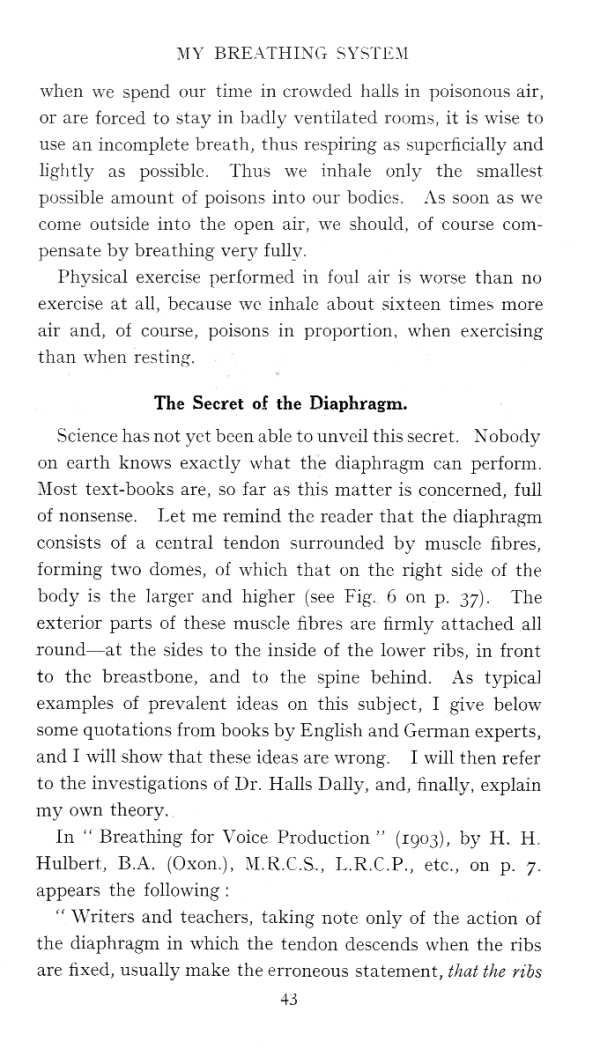52396 mbs 043

MY BREATHING SYSTEM
when we spend our time in crowded halls in poisonous air, or are forced to stay in badly ventilated rooms, it is wise to use an incomplete breath, thus respiring as supcrficially and lightly as possible. Thus we inhale only the smallest possible amount of poisons into our bodies. As soon as we come outside into the open air, we should, of course coin-pensate by breathing very fully.
Physical exercise performed in foul air is worse than no exercise at all, because we inhale about sixteen limes morę air and, of course, poisons in proportion, when exercising than when resting.
The Secret of the Diaphragm.
Science has not yet been able to unveil this secret. Nobody on carth knows exactly what the diaphragm can perform. Most text-books are, so far as this matter is concerned, fuli of nonsense. Let me remind the rcader that the diaphragm consists of a central tendon surrounded by muscle fibres, forming two domes, of which that on the right side of the body is the larger and higher (see Fig. 6 on p. 37). The extcrior parts of these muscle fibres are tirmly attached all round—at the sides to the inside of the lower ribs, in front to the breastbone, and to the spine behind. As typical examples of prevalent ideas on this subject, I give below some ąuotations from books by English and German experts, and I will show that these ideas are wrong. I will then refer to the investigations of Dr. Halls Daily, and, finally, explain my own theory.
In " Breathing for Yoice Production ” (1903), by H. H Hulbert, B.A. (Oxon.), M.R.C.S., I..R.C.P., etc., on p. 7. appears the following:
" Writers and teachers, taking notę only of the action of the diaphragm in which the tendon descends when the ribs are fixed, usually make the erroneous statement, that the ribs
43
Wyszukiwarka
Podobne podstrony:
22020 mbs 037 MY BREATHING SYSTEM Finally, we have the horizontal backward cpansion, forming the six
69745 mbs 028 MY BREATHING SYSTEM When the mucous membranc of the nose has become too cold, it is no
mbs 067 MY BREATHING SYSTEM The Great Mistake of Swedish Drill. As already mentioned, we ought to us
43484 mbs 050 MY BREATHING SYSTEM diaphragm which is brought into a nearly vertical position when th
74684 mbs 021 MY BREATHING SYSTEM Why should we Breathe through the Nose ? Naturę gave us a mouth wi
mbs 046 MY BREATHING SYSTEM Further, on p. 13, Dr. Hulbert vrites : “ By this mcthod of breathing wh
80109 mbs 009 MY BREATHING SYSTEMPART I CHAPTKR I WHAT DEEP-BREATHING EXERCISES ARE Eykrybouy knows
więcej podobnych podstron